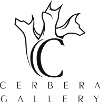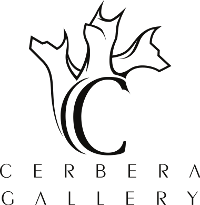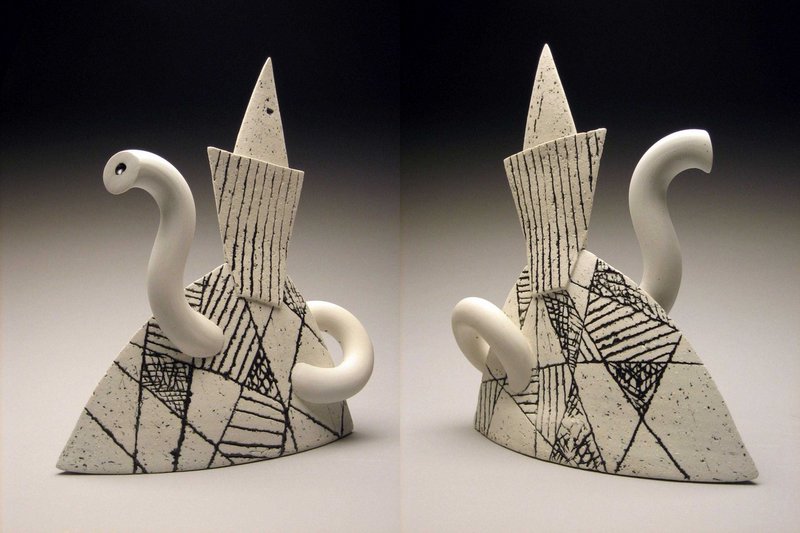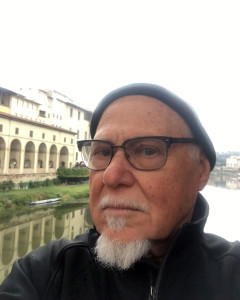
Harris Deller @ Cerbera Gallery – KCMO
“What we know next will change what happens next, and we can’t know what we’ll know next, since if we could we’d know it now.”
Karl Popper, philosopher
Harris Deller about his work: “The ceramic tradition of pottery making is the foundation of my practice. I am interested in dualities, contradictions and internal human dramas joined with the layering of time and history. My visual vocabulary consists of lines, geometric forms, basic color and repetition of simplified shapes, along with a strong affinity for precision, proportion and balance.
Pottery is familiar to us and we have a long association with these objects and understand some of the dualities particular to them. The relationship of the inside to the outside, the top to the bottom, form and function, these are accessible to most viewers. Pottery can exist as a sculptural form; works made for display, and at the same time hold on to the notion of function. Pottery can also be made for function and daily use employing tactile qualities and beauty, offering joy and pleasure to both the eye and the hand.”
The complexities and abstractness of pottery forms like the teapot and vase inspire Harris Deller. They are constructed from several shapes to make the final form. He also finds inspiration in the plate, the flat concave surface allowing me to approach it in ways similar to how a painter approaches a blank canvas. In addition, the surface of clay can be scratched and incised as well as glazed. Glaze is subjected to heat and influenced by the fire of the kiln. Unlike paint, glaze is transformed; it melts and is affected by gravity. Glaze is viscous and can be transparent or opaque. Glaze flows, surrounding and pooling into textures, fissures and patterns on the surface of the clay. It can be filled with crystals or streaked like an animal’s fur. Glaze imparts it’s own inherent abstract qualities to the work.
Pottery necessitates volume for use and that carries with it certain expectations and content such as a volume is “full” or “pregnant” with meaning. Through his work Harris Deller re-examines the role volume plays in pottery. For example, he make cups and teapots where the handle penetrates the volume. Harris Deller also makes cups and teapot – like forms where the volume is “suppressed.” Literally by squeezing the sides of the pot towards each other the air from the volume is removed and the form is altered. The nature of the pot is changed and two convex planes meet at an edge to define the volume. The pot now has 2 sides and alludes to being 2 dimensional and the emphasis is placed on the forms profile and contour.
“The illusion of 2 dimensions is enhanced through “mark making” on the planes. Incising and crosshatching into the clay’s surface lends to it the spirit of a drawing. I work with a very coarse white porcelain clay body and inlay the marks with a black glaze that accentuates the whiteness of the porcelain and the graphic quality of the work.
My practice finds inspiration from the “mallet shaped” vases of the Sung and Ming Dynasties, Pre-Columbian pots and Cycladic figures. I admire the vitality and soul of the sculptural forms of Hans Coper and the constructed “Stacked Pots” of Peter Voulkos.
Instead of working from a single piece of clay on the potter’s wheel, my work is constructed from several shapes. I alter cones and cylinders into trapezoid like shapes that I stack and join together. I will construct a form by combining at least 2 or more of these shapes. The technique lends itself to suppressing or altering the volume and the final forms put greater emphasis on the contours and planes of the pieces. In some work I will make each side distinct as in “there are two sides to every story.” At other times one side will mimic the other. Recently, inspired by the stainless steel sculpture from David Smith’s “Cubi Series,” I have become interested in stacking and building pottery from hollow geometric forms. Now instead of the work having 2 sides, it has 4.
I approach working from a phenomenological point of view, relying on the repetition and systems associated with pottery making along with permutations and combinations of form and surface. Making pattern from concentric arcs as a record of my involvement, time and emotion or serving as a recording of my heartbeat. Sometimes the pattern is reference to a fingerprint.
Paying careful attention to any changes in the space between the lines, or deviations in glaze, I look for anomalies and try to build upon those in subsequent works. It is important that my shapes have a precise contour, sometimes with an anthropomorphic stance. I use pattern to activate, mark time and record human activity. I use glaze to imply movement, passion and both are used to imply water and wind. My desire is to make vessels that are alluring, elicit a reaction and perhaps present a paradox.”

